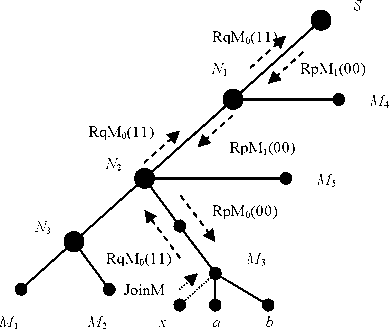■ Case 3: the new receiver is the first receiver joining through an LMR and this
LMR is not directly connected to a BNR.
In all these mentioned cases which will be discussed in detail in this section, it is assumed
that S is the multicast group source node, N1 to N3 are IMRs or BNRs, M1 to M5 are LMRs
and (a, b) and (x) are receivers already joined or need to join the multicast tree respectively.
■ Case 1:
In this case, there are previous members joined to the LMR where the new receiver member
will join. Figure 4.6 shows this case. Node x (the new receiver member) sends a JoinM to its
designated LMR M3, upon receiving this message, M3 will initiates a RqM0(11). Because
the value of S bit in the message is zero, this message will go directly to the source and it will
not be accessed by any of the IMRs or BNRs in the path to the source. Upon receiving this
message, the source S initiates and sends a RqM1(00) toward the new receiver(x). when this
message received by the BNR serving this new receiver, it unset the S bit and forward the
message to the LMR connecting this new receiver. It worth to notice that in this case there is
no changes in the multicast tree construction.

Figure 4.6 Joining process in SReM (Case 1)
|
Nodes |
MFTs | |
|
Beforex join |
Afterx join | |
|
S (Source) |
MTI | IP_Λ1 |
unchanged |
|
Λ'1 |
MTI | IP_Λ2 &IP_M |
unchanged |
|
Λ2 |
MTI | IP_Λ3 , IP_M5, IP_M5 |
unchanged |
|
Λ'3 |
MTI | IP_M1 & IP_M2 |
unchanged |
Join message
RqM or RpM
■ Case 2:
In this case, the new receiver (x) is joining a multicast group through an existing BNR, i.e the
new receiver’s LMR is attached to the first BNR directly. Figure 4.7 shows this case. The
new receiver node (x) will send a JoinM to the designated LMR (M3). Upon receiving this
message, M3 initiates and sends a RqM1(11) toward the source. The first IMR in the path to
67
More intriguing information
1. Fortschritte bei der Exportorientierung von Dienstleistungsunternehmen2. On s-additive robust representation of convex risk measures for unbounded financial positions in the presence of uncertainty about the market model
3. Segmentación en la era de la globalización: ¿Cómo encontrar un segmento nuevo de mercado?
4. How we might be able to understand the brain
5. Declining Discount Rates: Evidence from the UK
6. The name is absent
7. Tobacco and Alcohol: Complements or Substitutes? - A Statistical Guinea Pig Approach
8. BILL 187 - THE AGRICULTURAL EMPLOYEES PROTECTION ACT: A SPECIAL REPORT
9. The name is absent
10. From Aurora Borealis to Carpathians. Searching the Road to Regional and Rural Development